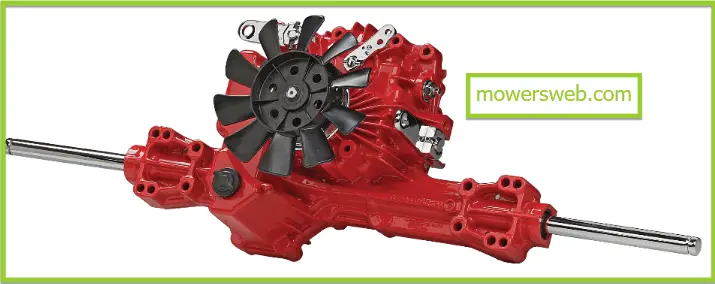The Tuff Torq K46 is a popular hydrostatic transmission used in many lawn tractors and riding mowers.
While it offers efficient and smooth operations, it’s not without its share of issues.
In this post, we will discuss some common problems that users may encounter with the Tuff Torq K46 and provide troubleshooting tips and solutions to address them effectively.
Let’s dive in.

Tuff Torq K46 Problems
1. Lack of Power or Sluggish Performance
One of the most common issues with the Tuff Torq K46 is a lack of power or sluggish performance.
If your mower struggles to climb hills or move at the desired speed, it could indicate a problem with the transmission.
Low fluid levels, a worn-out drive belt, or damage to internal components could be the cause of this issue.
2. Leaking Oil
Oil leaks are another prevalent issue with the Tuff Torq K46. If you notice puddles of oil under your mower or observe a significant drop in fluid levels, it’s essential to identify and address the source of the leak promptly.
Common causes of oil leaks include damaged seals, loose fittings, or cracks in the transmission housing.
3. Excessive Noise
Unusual noises coming from the Tuff Torq K46 can be indicative of underlying problems.
If you hear grinding, whining, or clunking sounds during operation, it may signal issues with the transmission.
Potential causes include damaged gears, worn bearings, or insufficient lubrication.
Read 5 Common Tuff Torq K57 Problems(With Solutions)
4. Loss of Drive
Experiencing a loss of drive or sudden disengagement of power while operating the mower can be frustrating.
This problem could stem from a broken drive belt, damaged gear, or a faulty control linkage. Proper inspection and troubleshooting are necessary to identify and resolve the issue effectively.
5. Overheating
Overheating is a critical concern for any transmission system, including the Tuff Torq K46.
Continuous operation under heavy loads or inadequate cooling can cause the transmission to overheat, leading to performance issues and potential damage.
Regular maintenance and ensuring proper cooling system function can help prevent this problem.
6. Vibration or Shaking
Excessive vibration or shaking during operation can indicate an imbalance or misalignment within the Tuff Torq K46 transmission.
This issue may arise from worn-out pulleys, damaged gears, or loose components. Addressing the root cause is crucial to maintaining smooth and efficient operations.
7. Difficulty Shifting Gears
If you find it challenging to shift gears smoothly or experience grinding when engaging the transmission, there may be a problem with the clutch or gear selector.
Adjustments or repairs may be required to restore proper shifting functionality.
Read Tuff Torq Vs Hydro-Gear(Find Out Which One Reigns Supreme)
8. Maintenance Issues
Neglecting regular maintenance can contribute to various problems with the Tuff Torq K46 transmission.
Failure to change the fluid, clean the cooling system, or inspect and replace worn parts can lead to decreased performance and premature wear.
Other Miscellaneous Problems
Apart from the issues mentioned above, users may encounter additional problems with the Tuff Torq K46 transmission.
These can include electrical faults, damaged wiring, or issues related to the control system. Thorough troubleshooting is necessary to identify and address these problems effectively.
Read Riding Mower Making Noise When Blades Are Engaged(Fixed)
Tuff Torq k46 Troubleshooting
Check the Fluid Level and Quality
Start troubleshooting by inspecting the fluid level and quality in the Tuff Torq K46.
Ensure that the transmission is filled with the recommended fluid and that the level is within the specified range.
If the fluid appears dirty, contaminated or has a burnt smell, it’s advisable to drain and replace it.
Inspect for Leaks and Seal Damage
Thoroughly examine the transmission for oil leaks and inspect the seals for any signs of damage. Replace any faulty seals or gaskets, and ensure that all connections are secure and leak-free.
Verify the Drive Belt Condition
Inspect the condition of the drive belt connected to the Tuff Torq K46. If it appears worn, cracked, or damaged, it should be replaced.
A faulty drive belt can lead to power loss and reduced performance.
Inspect and Clean the Cooling System
Check the cooling system components, such as the cooling fan and radiator, for any obstructions or debris.
Clean them if necessary to ensure proper airflow and cooling. Maintaining a clean and effective cooling system can prevent overheating.
Read Briggs and Stratton Engine Bogs Down Under Load(Solved)
Check for Damaged or Worn Parts
Carefully inspect all gears, pulleys, and bearings within the Tuff Torq K46 for any signs of damage or excessive wear.
Replace any worn-out components to maintain optimal performance and prevent further problems.
Perform Regular Maintenance
Adhering to the manufacturer’s recommended maintenance schedule is crucial to keeping the Tuff Torq K46 in good working condition.
This includes regular fluid changes, cleaning the cooling system, and inspecting and replacing worn parts as needed.
Read Powermore 420cc Engine Problems(With Solutions)
Tuff Torq Transmission Problems
| Problem Description | Possible Causes | Solutions and Recommendations |
|---|---|---|
| Transmission won’t engage | Low fluid level | Check and refill fluid to proper level |
| Damaged drive belt | Replace the drive belt if worn or damaged | |
| Faulty control linkage | Inspect and repair/control linkage | |
| Internal transmission damage | Consult a professional for diagnosis and repair | |
| Jerky or erratic movement | Worn drive belt | Replace the drive belt if it’s showing signs of wear |
| Air in the hydraulic system | Bleed the hydraulic system if necessary | |
| Faulty shift linkage | Inspect and adjust shift linkage if needed | |
| Traction control issues | Address issues with traction control mechanisms | |
| Leaking transmission fluid | Loose or damaged seals | Replace seals or tighten connections |
| Overfilled transmission | Drain excess fluid to the correct level | |
| Damaged transmission casing | Repair or replace the damaged casing | |
| Unusual noises during operation | Low or dirty fluid | Check fluid levels and replace with clean fluid |
| Worn internal components | Have a professional diagnose and repair internals | |
| Loose or damaged parts | Tighten or replace loose or damaged components | |
| Transmission overheating | Excessive load or towing | Avoid overloading the transmission |
| Low fluid level | Ensure the fluid level is correct | |
| Blocked cooling fins or fan | Clean cooling components and ensure proper airflow | |
| Loss of power or slipping gears | Worn drive belt or pulleys | Replace worn components as needed |
| Internal clutch or gear issues | Seek professional help to diagnose and repair | |
| Incorrect fluid type or level | Use recommended fluid and maintain proper level |
Tuff Torq K46 life Expectancy
The life expectancy of a Tuff Torq K46 transmission can vary depending on several factors, including usage, maintenance, and the type of equipment it’s installed in. On average, the Tuff Torq K46 transmission is designed to last around 300 to 500 hours of operation under normal conditions.
However, it’s important to note that factors such as heavy towing, rough terrain, improper maintenance, and overloading can significantly impact the lifespan of the transmission.
Regular maintenance, including checking and changing the transmission fluid according to the manufacturer’s recommendations, can help prolong the life of the Tuff Torq K46 transmission.
Read 5 Common Tuff Torq K57 Problems(With Solutions)
Tuff Torq K46 Oil Level
To check the oil level in a Tuff Torq K46 transmission, please follow these steps:
- Park on Level Ground: Make sure your equipment (such as a lawn tractor) is parked on a level surface to ensure an accurate reading.
- Locate the Oil Reservoir: The oil reservoir for the Tuff Torq K46 transmission is usually located on top of the transmission housing. It might have a yellow or black cap and a dipstick attached.
- Remove the Dipstick: Carefully remove the dipstick from the reservoir. Wipe it clean with a cloth or paper towel.
- Check the Oil Level: Insert the dipstick back into the reservoir, but do not screw it in. Then pull it out again to check the oil level. There may be markings on the dipstick indicating the proper range for the oil level.
- Add Oil if Necessary: If the oil level is below the recommended range, you’ll need to add transmission oil. Use the oil that the Tuff Torq K46 transmission’s manufacturer has recommended.
- Slowly pour the oil into the reservoir, checking the level with the dipstick as you go. Be cautious not to overfill.
- Recheck the Oil Level: After adding oil, reinsert the dipstick fully, then remove it again to confirm that the oil level is within the recommended range.
- Secure the Dipstick and Cap: Once you’re satisfied with the oil level, securely reinsert the dipstick into the reservoir and tighten the cap.
Final Remarks
The Tuff Torq K46 is a reliable hydrostatic transmission commonly found in lawn tractors and riding mowers.
While it offers efficient operation, certain problems may arise over time.
By understanding common issues and following the troubleshooting steps outlined in this article,
Users can address these problems effectively and ensure the optimal performance and longevity of their Tuff Torq K46 transmission.
Read 7 Toro V-Twin 708cc Engine Problems(With Solutions)
FAQs
How often should I change the transmission fluid in my Tuff Torq K46?
It is recommended to change the transmission fluid in the Tuff Torq K46 every 100 hours of operation or at least once a year, whichever comes first.
Regular fluid changes help maintain the transmission’s performance and extend its lifespan.
Can I replace the K46 transmission with a more durable option?
While it may be possible to replace the Tuff Torq K46 with a more durable transmission, it is essential to ensure compatibility with your specific lawn tractor or riding mower model.
Consult with a professional or contact the manufacturer for guidance on suitable replacement options.
Why is my Tuff Torq K46 making a grinding noise?
A grinding noise from the Tuff Torq K46 could indicate worn gears or bearings. It is advisable to have a professional inspect and repair the transmission to prevent further damage and ensure proper functionality.
What are some preventive measures to extend the life of the Tuff Torq K46?
Regular maintenance, including fluid changes, cleaning the cooling system, and inspecting for worn parts, is crucial for extending the life of the Tuff Torq K46.
Additionally, operating the mower within the recommended load limits and avoiding excessive heat buildup can contribute to its longevity.
Is it possible to repair the Tuff Torq K46 on my own?
While some simple maintenance tasks are doable by homeowners, repairing the Tuff Torq K46 transmission typically calls for expertise and specialized equipment.
It is recommended to consult with a professional or authorized service center for complex repairs to ensure a proper and safe resolution of the problem.
Read How to Bypass Safety Switch on Zero Turn(In 3 Easy Steps)




